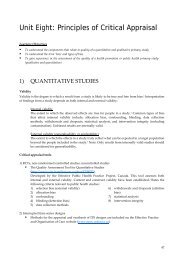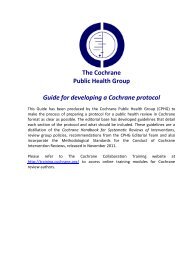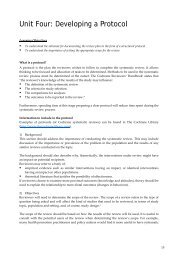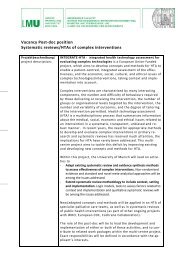Train the Trainer Course book - Cochrane Public Health Group
Train the Trainer Course book - Cochrane Public Health Group
Train the Trainer Course book - Cochrane Public Health Group
Create successful ePaper yourself
Turn your PDF publications into a flip-book with our unique Google optimized e-Paper software.
this level. Often this is not <strong>the</strong> case, as <strong>the</strong> intervention is allocated to schools (for practical reasons)<br />
and individual outcomes (eg. behaviour change) are analysed. In <strong>the</strong>se instances, a cluster analysis<br />
(taking into account <strong>the</strong> different levels of allocation and analysis) should be reported.<br />
For fur<strong>the</strong>r information about cluster studies read “Ukoumunne OC, Gulliford MC, Chinn S, Sterne<br />
JA, Burney PG. Methods for evaluating area-wide and organisation-based interventions in health and<br />
health care: a systematic review. <strong>Health</strong> Technol Assess. 1999;3(5):iii-92.”<br />
Example: A power calculation indicated that with five schools in each arm, <strong>the</strong> study would have<br />
80% power to detect and underlying difference in means of a normally distributed outcome measure<br />
of ≥1.8 standard deviations at <strong>the</strong> 5% significance level and 65% to detect a difference of 1.5 SD. This<br />
took into account <strong>the</strong> cluster randomisation design.<br />
Example: The statistical model took into account <strong>the</strong> lack of independence among subjects within <strong>the</strong><br />
school, known as <strong>the</strong> clustering effect.<br />
8) Integrity of intervention<br />
Critical appraisal should determine if results of ineffectiveness within primary studies is simply due<br />
to incomplete delivery of <strong>the</strong> intervention (failure of implementation) or a poorly conceptualised<br />
intervention (failure of intervention concept or <strong>the</strong>ory) 6,7 . Evaluating a program that has not been<br />
adequately implemented is also called a Type III error 8 . Assessing <strong>the</strong> degree to which interventions<br />
are implemented as planned is important in preventive interventions which are often implemented in<br />
conditions that present numerous obstacles to complete delivery. 6 A review of smoking cessation in<br />
pregnancy 9 found that in studies which measured <strong>the</strong> implementation of <strong>the</strong> intervention <strong>the</strong><br />
implementation was less than ideal.<br />
In order to provide a comprehensive picture of intervention integrity five dimensions of <strong>the</strong><br />
intervention should be measured. These five factors are adherence, exposure, quality of delivery,<br />
participant responsiveness, and program differentiation (to prevent contamination). 6<br />
Adherence: <strong>the</strong> extent to which specified program components were delivered as prescribed in<br />
program manuals.<br />
Exposure: an index that may include any of <strong>the</strong> following: (a) <strong>the</strong> number of sessions<br />
implemented; (b) <strong>the</strong> length of each session; or (c) <strong>the</strong> frequency with which program<br />
techniques were implemented.<br />
Quality of delivery: a measure of qualitative aspects of program delivery that are not directly<br />
related to <strong>the</strong> implementation of prescribed content, such as implementer enthusiasm, leader<br />
preparedness and training, global estimates of session effectiveness, and leader attitude<br />
towards <strong>the</strong> program.<br />
Participant responsiveness: a measure of participant response to program sessions, which may<br />
include indicators such as levels of participation and enthusiasm.<br />
Program differentiation: a manipulation check that is performed to safeguard against <strong>the</strong><br />
diffusion of treatments, that is, to ensure that <strong>the</strong> subjects in each experimental condition<br />
received only <strong>the</strong> planned interventions. Contamination may be a problem within many public<br />
health and health promotion studies where intervention and control groups come into contact<br />
with each o<strong>the</strong>r. This bias is minimised through <strong>the</strong> use of cluster RCTs.<br />
73








